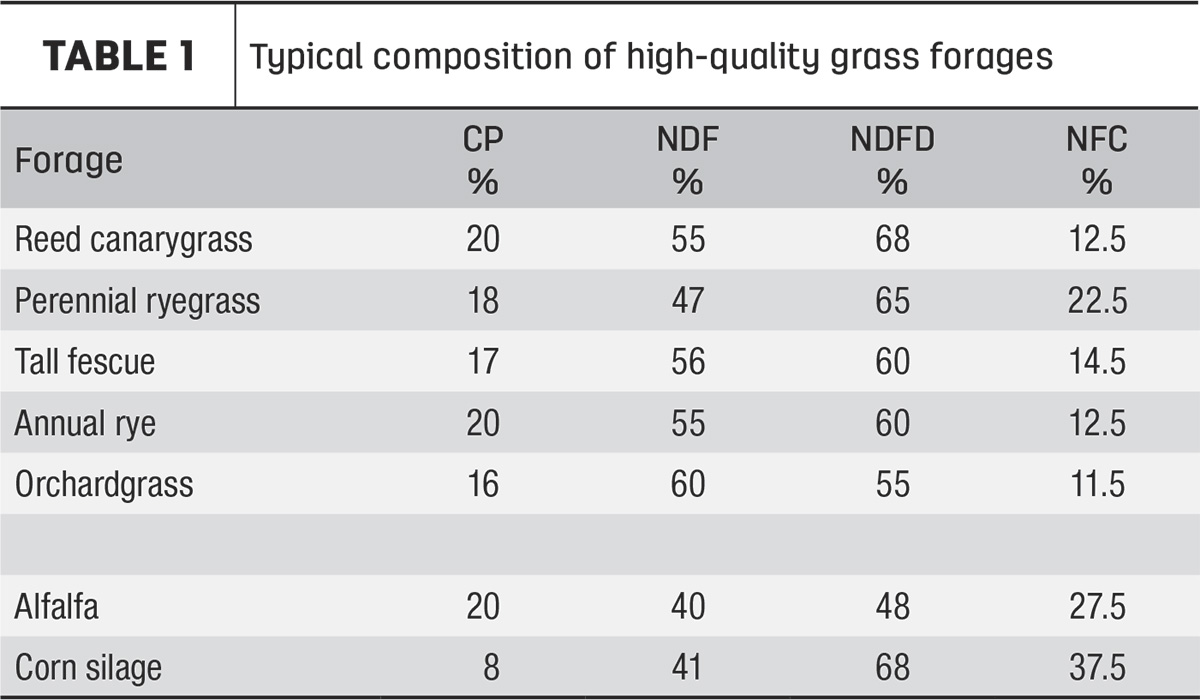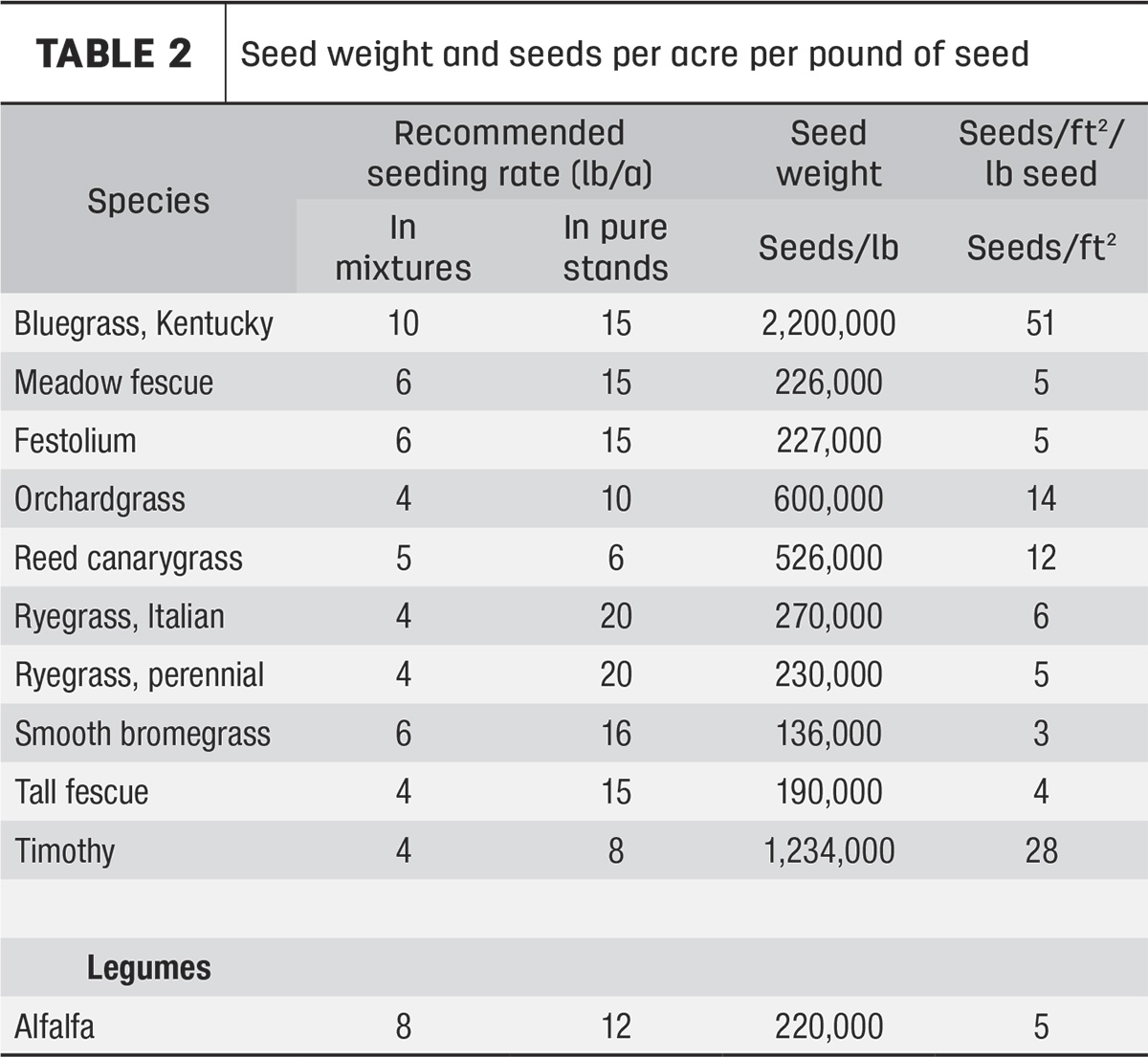There are several benefits to seeding alfalfa-grass mixtures rather than pure alfalfa stands. A mixture gives biodiversity which allows:
- Good yield under diverse growing conditions since each variety/species will respond to environmental conditions differently. Cool-season grasses start growing earlier in the spring and grow later in the fall when weather is cooler, while alfalfa grows more when temperatures are higher. The cool-season grass grows better under wetter conditions, and the alfalfa grows better in dry conditions.
- Multiple maturity dates to ensure a wider harvest window, especially after first cutting when cool-season grasses do not head out again.
- Legumes and grasses have differing leaf and root traits that allow for greater combined use of light, moisture and minerals.
- Grasses in a mixture with tap-rooted alfalfa provide protection from heaving of soils during spring.
- Alfalfa-grass mixtures dry faster than either pure alfalfa or pure grass forage.
- Grasses are more tolerant of traffic than legumes.
- Alfalfa’s nitrogen-fixing capability reduces a farm’s dependence on purchased nitrogen. The legume will also provide nitrogen for the next crop grown, while the grass does not.
There can also be nutritional benefits to feeding alfalfa-grass mixtures.
First, for animals other than milking dairy cows, alfalfa may be too rich and put on unwanted weight. Alfalfa-grass mixtures with their higher fiber may better meet the nutritional requirements of youngstock, beef cows, dairy heifers and horses.
For milking dairy cows, we should recognize that alfalfa mixtures with at least 40% grass tend to have greater total fiber than pure alfalfa, but a higher proportion of it is digestible (see Table 1). The higher neutral detergent fiber digestibility (NDFD) of a forage mix doesn’t necessarily mean that dry matter intake (DMI) and milk production will improve. Increasing the proportion of grasses slows passage rate, which will generally reduce the benefit of increased NDFD on DMI.

Therefore, alfalfa-grass mixtures are possibly a good fit with high-nonfibrous carbohydrate, low-fiber diets (i.e., high corn silage diets). The forage mixtures have the potential to reduce subacute rumen acidosis due to increased fiber levels. Using alfalfa-grass mixtures in high corn silage dairy rations may also reduce laminitis, which is a problem at low levels in many dairy herds.
Seventy-five seeds per square foot is normally adequate for stand establishment, assuming good seed-to-soil contact and seeding at 1/4-inch depth. Table 2 gives seed weight and seeds per acre per pound of seed. For example, to provide a 30%-40% grass mix, a seeding rate of 4 pounds per acre is recommended for orchardgrass. The resulting alfalfa-grass mix will depend on the growing conditions following seeding: Cool, wet conditions will favor the grass and suppress alfalfa seedlings, while hot and/or dry conditions will favor alfalfa.

It is important to select late-maturing grass varieties, especially of the orchardgrass, because the less-expensive early types will head and be ready to harvest in the spring before alfalfa reaches harvest maturity.
Timothy and smooth bromegrass are no longer recommended for mixtures with alfalfa seeded for dairy because the grasses will not persist with aggressive 25- to 30-day cutting schedules.
Grass proportion in mixtures will be highest spring and fall. Smooth bromegrass and timothy are notorious for having 60%-70% of their total season yield in first cutting. There are some genetic differences among varieties of tall fescue, with some varieties yielding more consistently throughout the season than other varieties.
Grass proportion often increases as stands age because legumes are less persistent than grasses.
The above refers only to alfalfa and grasses seeded together (either in the spring or in the fall). It does not refer to interseeding grasses into thinned alfalfa stands. While such interseeding may appear to be beneficial since grasses will establish, the interseeding will have little impact on yield. Ryegrass responds quickly but does not grow well in summer heat or drought; orchardgrass and tall fescue take 60-90 days to begin producing yield. The most economical option for thinned alfalfa stands is to turn the stands over, take the legume credits and reseed alfalfa into another field.









